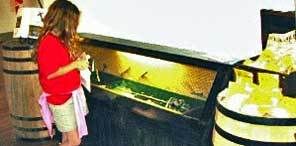
Over 380 years after it slipped beneath the surface of the waters in the stormy Straits of Florida, a sword from the famed Spanish gallon, Nuestra Señora de Atocha, has a new home in the St. Augustine & St. Johns County Visitor Information Center. The story of the sword’s arrival and preservation starts a decade ago.
In 1997, as part of the city’s conservation of an anchor from the Atocha, three display cases were setup containing a variety of artifacts that highlighted the cargo carried by this Spanish galleon. One of the artifacts on display was a complete sword, one of only a few that was still intact since most of the swords had been broken when the treasure ship was lost during a violent hurricane in 1622. This sword had been the property of Mr. Jud Chalmers, who gifted the relic to the City of St. Augustine, Florida, to be placed on public display.
During the two years it took to conserve the anchor, the sword resided with the anchor at the Castillo de San Marcos National Monument. When completed, the preserved anchor would be St. Augustine’s contribution to the Museum of Anchors near Aviles, Spain: St. Augustine’s sister city.
The city then set about the task of preserving the sword. The encrustation of sand and shell that had formed around it during the more the 350 years it lay submerged in the tropical waters off the Florida Keys had actually protected the relic, but with the its removal from this watery environment, the salt molecules that had permeated the iron began to swell and crack the medal. Eventually, the salt molecules would have destroyed the sword.
The Atocha sword was sent to the State of Florida’s conservation lab in Tallahassee where conservators carefully removed a portion of “the rock†or encrustation. Because more than 20 years had elapsed between its discovery and conservation, very little of the sword’s iron actually remained.
By carefully removing the rock, the conservators were able to define the outline of the sword, especially the blade and hand guard. From this outline, a cast was made of the sword’s blade. All that remains of the original blade is a thin band of iron, which is adjacent to the reconstructed blade. To illustrate how the rock formed around the sword, the hand guard outline was left alone.
The only part of the sword not adversely affected by salt molecules was the grip or handle. Thin silver bands had been wrapped around the handle effectively protecting the iron.
According to Carl Halbirt, city archaeologist, the sword is likely similar to those used by high ranking soldiers in St. Augustine in the early 17th century. This conclusion is based on the silver covering the handle.
The sword’s display is joined by a number of other archaeological artifacts recovered by the City of St. Augustine through its archaeological preservation ordinance. These display items include tools, pottery, weaponry, and clothing apparel all located at the Visitor Information Center, 10 Castillo Drive. The VIC is open seven days a week from 8:30am until 5:00pm.
City of St. Augustine promotional photograph
Discover more from HISTORIC CITY NEWS
Subscribe to get the latest posts sent to your email.

